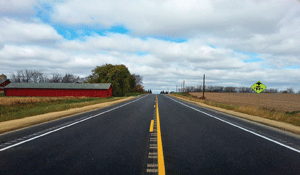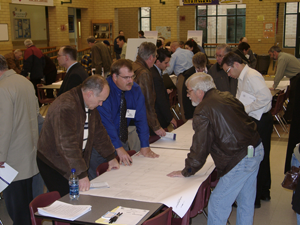#1 Select project |
#2 Investigate alternatives |
#3 Final approvals |
#4 Project design |
#5 Prepare for construction |
#6 Construction
Strong highway connections drive Wisconsin’s economy.
 To ensure Wisconsin's transportation network meets personal and business needs it is also necessary to develop strong connections between WisDOT and the state's citizens.
To ensure Wisconsin's transportation network meets personal and business needs it is also necessary to develop strong connections between WisDOT and the state's citizens.
WisDOT welcomes public comments and seeks to work in partnership with citizens and communities to develop a safe, efficient transportation system. A highway project, from concept through construction, is a complex process that involves time, money, expertise in many areas and citizen involvement.
The process of constructing a highway consists of six phases. Communication between citizens and WisDOT is essential at every point in the process. Depending on a project’s complexity, it may take one to six years (or longer) for a highway project to move from concept through construction.
Each year WisDOT completes 350 to 400 state highway projects, costing an average of $1.5 million each. In addition, WisDOT returns more than $500 million to local governments to help finance the operation and improvement of locally-owned roads, streets and bridges.
Phase one: Select project
Highway projects are selected based on a variety of criteria. WisDOT regions identify local needs by analyzing:
- Public concerns
- Traffic crash reports
- Pavement and bridge condition reports
- Traffic volume reports
- Traffic trends
- Forecasts for future demands
A highway’s concept takes shape through a series of public meetings. Citizens are encouraged to ask questions about the type of improvement being considered and how it will improve the quality of the transportation system.
Regional staff work with the public to describe the project, define the project’s goal and outline the need for the project. A preliminary project list is submitted by WisDOT’s five transportation regions to a statewide program.
If a project is selected to be funded, it becomes part of the state’s
Six-Year Highway Improvement Program. The program is updated every two years to support citizens' current needs.
A Major Highway Project - a complex and costly project which requires a capacity expansion of over five miles or creation of two and half miles of highway on a new location - requires a more extensive environmental review, public involvement and approval by the Transportation Projects Commission, the State Legislature and the Governor.
Phase two: Investigate alternatives
After a project is selected to be in the Six-Year Highway Improvement Program, WisDOT continues to listen to citizens' concerns through public information meetings.
Sometimes it is possible for a WisDOT representative to personally visit homes, businesses or farms prior to or during a construction project. A visit from WisDOT personnel offers citizens the chance to gain information, air concerns, discuss issues, or ask for assistance. WisDOT works with citizens to identify project alternatives.
 Each alternative is analyzed and assessed based on cost and its impact on:
Each alternative is analyzed and assessed based on cost and its impact on:
- People
- Businesses
- Farmlands and wetlands
- Endangered species
- Historic structures and artifacts
- Landfills
Public meetings are held to present the recommended improvements with more specific detail about impacts. Small changes can be applied to the plan at this point to help address public concerns and fine-tune the design.
Phase three: Obtain final approvals
WisDOT sends information about its acquisitions from farm operations to the Department of Agriculture, Trade and Consumer Protection (DATCP).
DATCP reviews the information and determines whether to prepare an Agricultural Impact Statement (AIS). When DATCP prepares an AIS it sends copies to the affected farm operations, their legislators and the public. WisDOT commonly includes the AIS in its Environment Impact Statements.
Environmental documents are sent to the Federal Highway Administration (FHWA) for approval if it is a federal project. Similarly, projects that are state funded are approved by WisDOT.
Citizen input is sought throughout the development of the Environmental Impact Statement (EIS) and they may request a copy of the Draft EIS. A public hearing is held to obtain citizen comments on the Draft EIS. However, citizens can give feedback to the transportation region where the project is located at any time.
View more detail on the environmental information page.
Phase four: Develop project design
The specific project route and details are finalized in this phase. Real estate staff meet with affected property owners to discuss land purchases and relocation plans. Real estate staff make every effort to ensure that offering prices reflect "just compensation" for the property.
Through the "In This Together" program, WisDOT works with local businesses to diminish the economic effect of the project. WisDOT offers help to businesses by:
- Maintaining access for customers, employees and service vehicles.
- Posting highway signs that point drivers to the business districts.
- Permitting businesses to temporarily post signs in the highway right of way to reassure customers that businesses are accessible.
- Working with business groups to inform citizens, identify alternate routes and promote business.
A project plans, specifications and estimates package is prepared in this phase. It includes:
- Plans - drawing of the physical layout of project.
- Specifications - how each item in the plan is to be built.
- Engineering estimates - listing and estimate of cost of each item of work.
Access management is also analyzed in this phase. Access management is a tool WisDOT uses to ensure that the existing highway system continues to perform with acceptable efficiency and safety.
Phase five: Prepare for construction
The WisDOT Bureau of Highway Construction reviews each plans, specifications and estimates package and prepares it for contractor bidding.
By this time, all land required for the project has been purchased and the project site is prepared for construction. WisDOT coordinates its construction schedule with utility companies who may need to replace sewer, gas, power or phone lines at the same time. Citizens are notified of utility service interruption in advance.
Bids for projects are advertised in the Daily Reporter and Western Builder magazine. Received bids are checked for completeness and accuracy. Awarded contracts are forwarded to the Governor for signature.
Construction usually starts within 30 to 45 days after the contract is awarded, except during winter. The typical construction season is from April to November.
WisDOT sends news releases to area media to keep citizens informed of project starting dates and any changes in traffic or construction.
Phase six: Construction
A pre-construction meeting is held with the contractor,
 local utilities, Department of Natural Resources (DNR) and local government officials.
local utilities, Department of Natural Resources (DNR) and local government officials.
WisDOT works with property owners and meets with local businesses and contractors throughout construction. WisDOT ensures all prior commitments to landowners, such as access to homes and businesses, are fulfilled.
Citizens are kept informed of construction progress through meetings and news releases sent to local media. Websites, project newsletters and brochures are developed for larger projects.
When requested by local officials, completion of a major project may be celebrated with a ribbon cutting.
The roadway is inspected every two years to monitor its condition.